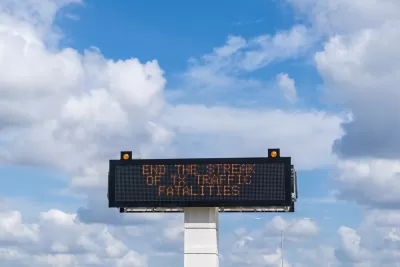Critics of the state’s ‘Be Safe. Drive Smart.’ campaign say the messaging puts the onus on pedestrians and cyclists while failing to address the lack of robust pedestrian and bike infrastructure in many of its cities.

Writing in Next City, Benton Graham describes the criticism faced by the Texas Department of Transportation (TxDOT) for its messaging approach to road safety, which in most cases places the blame for crashes squarely on pedestrians (the top reason for pedestrian deaths, according to the department’s website, is “Pedestrians failing to yield the right-of-way to vehicles”) and cyclists.
Meanwhile, “While the state agency lists safety as its number one priority, it only dedicated around 4% of its funds to safety initiatives in its 10-year plan,” Graham notes. Jay Blazek Crossley, executive director of Farm & City and an advocate for safer roads, says “TxDOT investing in safe, multimodal streets is the most important thing that it can do to make roads less dangerous.”
Advocates like Blazek Crossley see cause for optimism in recent state and local initiatives, however. “In addition to infrastructure changes, Blazek Crossley said there is opportunity for safety improvements through policy changes.” FOr example, “The Lisa Torrey Smith Act passed during the 2021 Texas Legislative Session requires drivers to stop and yield to pedestrians in crosswalks.” TxDOT also recently added a pedestrian design section to its roadway design manual, and cities like Houston are making serious investments in bike and pedestrian infrastructure.
FULL STORY: Texas Is Trying To Fight Pedestrian And Cyclist Deaths With Words. Is It Enough?

Planetizen Federal Action Tracker
A weekly monitor of how Trump’s orders and actions are impacting planners and planning in America.

Map: Where Senate Republicans Want to Sell Your Public Lands
For public land advocates, the Senate Republicans’ proposal to sell millions of acres of public land in the West is “the biggest fight of their careers.”

Restaurant Patios Were a Pandemic Win — Why Were They so Hard to Keep?
Social distancing requirements and changes in travel patterns prompted cities to pilot new uses for street and sidewalk space. Then it got complicated.

Platform Pilsner: Vancouver Transit Agency Releases... a Beer?
TransLink will receive a portion of every sale of the four-pack.

Toronto Weighs Cheaper Transit, Parking Hikes for Major Events
Special event rates would take effect during large festivals, sports games and concerts to ‘discourage driving, manage congestion and free up space for transit.”

Berlin to Consider Car-Free Zone Larger Than Manhattan
The area bound by the 22-mile Ringbahn would still allow 12 uses of a private automobile per year per person, and several other exemptions.
Urban Design for Planners 1: Software Tools
This six-course series explores essential urban design concepts using open source software and equips planners with the tools they need to participate fully in the urban design process.
Planning for Universal Design
Learn the tools for implementing Universal Design in planning regulations.
Heyer Gruel & Associates PA
JM Goldson LLC
Custer County Colorado
City of Camden Redevelopment Agency
City of Astoria
Transportation Research & Education Center (TREC) at Portland State University
Camden Redevelopment Agency
City of Claremont
Municipality of Princeton (NJ)





























